
With production of the Toyota FJ Cruiser rolling to an end, this retro inspired Cruiser has been on our minds of late. One particular rig which springs to mind was this modified FJ which first appeared in 4X4 Australia back in 2013.
This story first appeared in the March 2013 issue of 4X4 Australia.
Since the release of the FJ Cruiser back in 2011, this rig has been quite popular, motivating enthusiasts to modify their 4x4 vehicles. Similar to Jeep’s Wrangler, many aftermarket specialists, clubs and enthusiasts have appeared, willing to help customise FJs to their owners’ wishes.
Many dismiss the FJ as a tourer because it lacks a diesel engine, yet the stock 4.0-litre petrol V6 has proven to not only be economical, but capable of delivering plenty of grunt. Some enthusiasts can never have enough power, though, and TRD (Toyota Racing Development) supercharger kits - available for earlier versions of the 1GR-FE engine - have allowed owners to generate even more power.
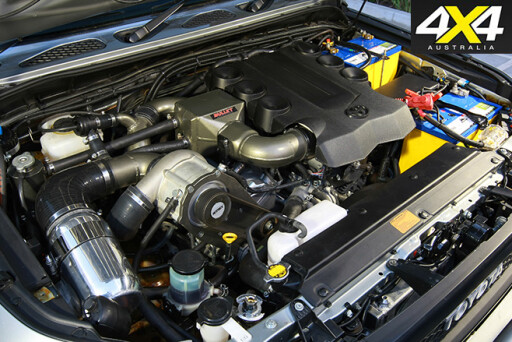 Australian-delivered FJs have the 1GR-FE V6. It’s equipped with variable valve timing on both the inlet and exhaust valves (dual VVT-i), as well as different cylinder heads to the early models that were only sold in the USA. The TRD supercharger kits don’t fit those engines, but that didn’t stop Australia’s innovative aftermarket industry. Queensland’s Bullet Cars developed its own supercharger package for Aussie FJs, and this fully-loaded example takes it to the extreme.
Australian-delivered FJs have the 1GR-FE V6. It’s equipped with variable valve timing on both the inlet and exhaust valves (dual VVT-i), as well as different cylinder heads to the early models that were only sold in the USA. The TRD supercharger kits don’t fit those engines, but that didn’t stop Australia’s innovative aftermarket industry. Queensland’s Bullet Cars developed its own supercharger package for Aussie FJs, and this fully-loaded example takes it to the extreme.
Bullet’s bolt-on kit for the FJ makes around 204kW at the tyres, with the blower running 6psi of boost. But that wasn’t enough for the owner of this FJ. He wanted all he could get from the improved set-up, so Bullet developed a one-off kit for him.
To produce more power more boost was sought, and this required a lower compression ratio. This was achieved by replacing the pistons and conrods, but, again, the established product to do the job doesn’t fit the newer engine. A new set of forged pistons had to be custom-made for this engine, and they drop the comp ratio from the standard 10.5:1 to a more usable 9.2:1.
 The lower comp allows more boost, and the Rotrex C38 supercharger is now pumping 10psi into this engine at 5400rpm. That’s enough to produce 232kW at the tyres, up from 148kW at the tyres as standard.
The lower comp allows more boost, and the Rotrex C38 supercharger is now pumping 10psi into this engine at 5400rpm. That’s enough to produce 232kW at the tyres, up from 148kW at the tyres as standard.
There was good reason for needing more power in this FJ. The plans for it included much bigger tyres that required more grunt to turn them, as well as a load of accessories that would add weight. Like the custom build of the engine, most of the gear fitted to the FJ is either modified or a one-off fabrication.
John Rea managed the project for an owner who wishes to remain anonymous. John is a military 4x4 enthusiast, and this shows in many aspects of the FJ such as the Hummer tow/tie down hooks, the WWII vintage aerial mount on the spare wheel, and the pintle hook tow hitch. He applied his many years of experience from playing with everything from WWII Jeeps to Humvees, to the modern Toyota 4x4.
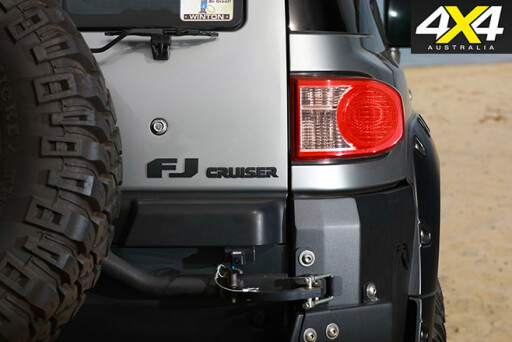 John wasn’t keen on the massive 325/65 R18 Mickey Thompson MTZ tyres, preferring more practical, smaller tyres for off-road use, but said the owner insisted on them from the outset. That’s 35 inches of rubber in the old money and there are six of ’em when you count the two spares. They mount to ‘Fuel Boost’ alloy wheels that have had the black coating machined off the rim dish for a unique look. The wheels cover drilled and slotted brake discs; the front ones clamped by monster JBT six-piston calipers.
John wasn’t keen on the massive 325/65 R18 Mickey Thompson MTZ tyres, preferring more practical, smaller tyres for off-road use, but said the owner insisted on them from the outset. That’s 35 inches of rubber in the old money and there are six of ’em when you count the two spares. They mount to ‘Fuel Boost’ alloy wheels that have had the black coating machined off the rim dish for a unique look. The wheels cover drilled and slotted brake discs; the front ones clamped by monster JBT six-piston calipers.
Even with the extra power the supercharger affords, the oversize rubber saps performance requiring lower 4.88:1 crown wheel and pinion gears in the diffs to bring out the best in the blown engine. The FJ Cruiser has an electronically-actuated diff lock in the rear end as standard, and this has been supported by an ARB Air Locker in the front diff.
An ARB compressor provides the air for the front locker, as well as to air fittings at the front of the vehicle. ARB also made the diff cover for the rear housing that strengthens and protects the differential. Piranha extended diff breathers are utilised to keep water out.
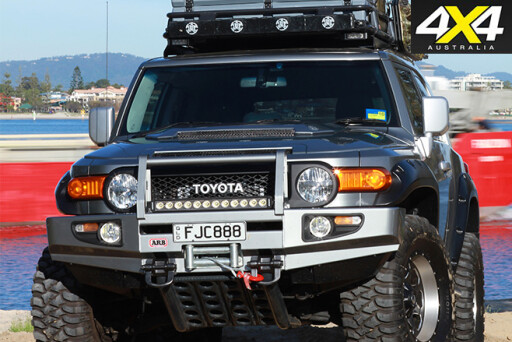 The suspension has been upgraded by hardcore off-road specialists Superior Engineering – staff there fitted three-inch lifted coils, ProFender remote-reservoir shock absorbers, extended brake lines, and swaybar links. To keep the wheel alignment in spec with the big rubber, the upper control arms were replaced with adjustable units also made by Superior Engineering.
The suspension has been upgraded by hardcore off-road specialists Superior Engineering – staff there fitted three-inch lifted coils, ProFender remote-reservoir shock absorbers, extended brake lines, and swaybar links. To keep the wheel alignment in spec with the big rubber, the upper control arms were replaced with adjustable units also made by Superior Engineering.
For a different look for the frontal protection, the ARB bullbar has had its upper side bars removed and smoothed off. What isn’t as obvious is the 35mm sectioned out of both ends of the bar to have it fit tighter within the lines of the vehicle. A 9000lb Warn winch resides inside the bar, with a Narva LED lightbar on top of it. The underside bash guard is a heavy-duty piece that was custom-made by John Rea.
 Bullet did the mods to the front bar and also fabricated the rock-rails in steel tube. They have been designed to fit up close to the sills and protect the stainless-steel exhaust that runs inboard of them and exits just ahead of the back wheels. The exhaust is a dual 2.5-inch system behind ceramic-coated extractors that gives this FJ a loud growly note – it barks when the go pedal is mashed.
Bullet did the mods to the front bar and also fabricated the rock-rails in steel tube. They have been designed to fit up close to the sills and protect the stainless-steel exhaust that runs inboard of them and exits just ahead of the back wheels. The exhaust is a dual 2.5-inch system behind ceramic-coated extractors that gives this FJ a loud growly note – it barks when the go pedal is mashed.
The rear bar was imported from Fab Fours in the USA and it incorporates the spare-wheel carrier, tow-hitch receiver and rear quarter panel protection. It’s a beautiful (and expensive) piece of kit, but required the chrome bolts to be replaced with stainless-steel ones to stop them rusting in the Aussie climate.
Like every aspect of this FJ build, there are a few custom touches to the body, too. Things like the Bushwhacker wheelarch flares and the functional bonnet scoop – which was made by Bullet – stand out, but others, such as the removal of the side indicators, the black painted badges and grille, and the colour-coded roof are more subtle.
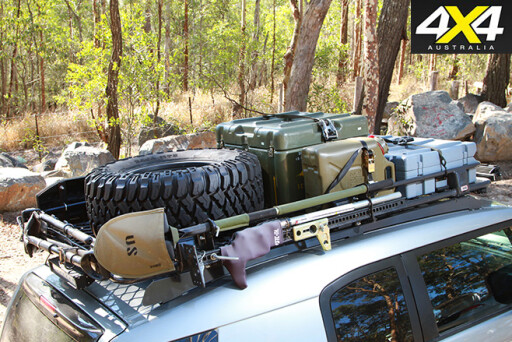 Up top, an ARB roof-rack is fully loaded with the second spare wheel and tyre, a couple of jerry cans, a few Space Cases, shovels, MaxTrax, and a high-lift jack. The forward-facing light bar is from Rigid Industries with Narva LEDs providing light to the sides and another Narva light bar at the rear of the rack. The crew at ARB’s Caboolture store fitted all the ARB gear and wired in the lights. They also installed a Redarc BCDC 1225 dual-battery isolator and charger, as well as a Long Ranger 120-litre replacement fuel tank.
Up top, an ARB roof-rack is fully loaded with the second spare wheel and tyre, a couple of jerry cans, a few Space Cases, shovels, MaxTrax, and a high-lift jack. The forward-facing light bar is from Rigid Industries with Narva LEDs providing light to the sides and another Narva light bar at the rear of the rack. The crew at ARB’s Caboolture store fitted all the ARB gear and wired in the lights. They also installed a Redarc BCDC 1225 dual-battery isolator and charger, as well as a Long Ranger 120-litre replacement fuel tank.
The roof rack is needed, as the FJ doesn’t have a lot of space inside for gear; especially this one, as there’s a 70L Engel fridge on a slide and massive subwoofer box taking up interior real estate. The sub box is part of a comprehensive Alpine audio/visual system that includes sat-nav and a drop-down screen for showing DVD movies to anyone in the back seat. Other interior extras include a GME UHF radio, ARB-style switches to control lights and ARB accessories, and a fire extinguisher.
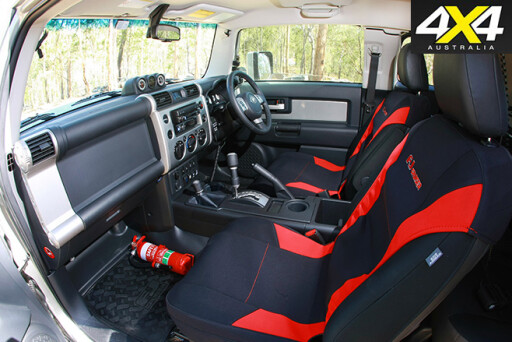 This FJ Cruiser has been built for style and performance, but it's also been built with a purpose. The owner plans to take it to Cape York with a group of mates to test just how well all the modifications come together to improve what is already a good package in the stock FJ Cruiser. Speaking of the modifications, there’s a Queensland Transport ‘Blue plate’ fitted to it, certifying that all the mods are legal and roadworthy in the Sunshine State.
This FJ Cruiser has been built for style and performance, but it's also been built with a purpose. The owner plans to take it to Cape York with a group of mates to test just how well all the modifications come together to improve what is already a good package in the stock FJ Cruiser. Speaking of the modifications, there’s a Queensland Transport ‘Blue plate’ fitted to it, certifying that all the mods are legal and roadworthy in the Sunshine State.
BLOW FOR GO
Bullet’s regular supercharger kit for the 1GR-FE 4.0-litre V6 engine is designed as a bolt-on kit, meaning that it can be fitted without internal modifications to the engine, thus saving the cost of a rebuild.
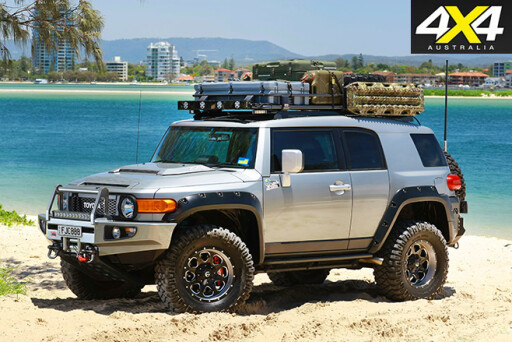 The kit includes a C38 Rotrex supercharger with internal oil pump, oil reservoir, oil filter, oil lines and clamps, oil, external oil cooler, mounting brackets, drive belt, all hoses, fasteners, plumbing with silicon hoses and clamps, air-to-water intercooler, air cleaner, auxiliary boost injector and step-by-step installation instructions. You’ll also need a custom ECU, and Bullet can help you out there, too, as well as with full drive-in, drive-out installation.
The kit includes a C38 Rotrex supercharger with internal oil pump, oil reservoir, oil filter, oil lines and clamps, oil, external oil cooler, mounting brackets, drive belt, all hoses, fasteners, plumbing with silicon hoses and clamps, air-to-water intercooler, air cleaner, auxiliary boost injector and step-by-step installation instructions. You’ll also need a custom ECU, and Bullet can help you out there, too, as well as with full drive-in, drive-out installation.
In this configuration the supercharged engine produces approximately a 40 per cent gain in performance, taking the power to around 204kW at the tyres, with the blower pumping in 6psi of boost.



COMMENTS